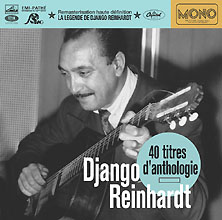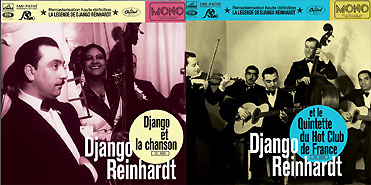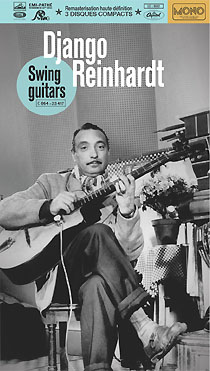Django Reinhardt, a legend
Tribute to the Gypsy With Golden Fingers
Paris
16/05/2003 -
Writing of Reinhardt’s death in 1953, Jean Cocteau declared, "Django dying is like one of those gentle big cats who die in a cage. He lived his life the way we all dream of living - in a Gypsy caravan." Even at the height of his fame the legendary guitarist used to leave the showbizz spotlights every night and wend his way home to his simple caravan. Django, the incarnation of freedom and independence, shrugged off the warmth of creature comforts and assumed his Gypsy roots with pride.
The young prince with the jet-black eyebrows launched his professional career at the age of 13, playing in a Parisian dance-hall on the rue Monge. Django’s flamboyant dress sense was already in evidence. A photo of the time shows the young guitarist immaculately turned out in a black, double-breasted suit. The very picture of masculine elegance! But it was not so much Django’s dress sense that blew people away, it was his incredible talent for reproducing a tune he had only heard once. What’s more, the young prodigy was totally illiterate and when he made his early recordings he was incapable of spelling his name (hence the signatures "Iango Renard" on the records released on Vaissade or "Jean Got" on those released on Marceau !)
Django’s real talent would explode later, of course, after the famous fire in 1928 which cost him the use of the ring finger and little finger on his left hand. Django suffered horrific burns in the fire, lying in bed in agony for an entire eighteen months. But several months into his convalescence someone came up with the bright idea of taking him a guitar – which Django was determined to play! The miracle happened and three years after his accident the painter Emile Savitry spotted Django on the French Riviera and offered to put him up at his house. It was Savitry who introduced Django to jazz and Jean Cocteau would later praise the young musician’s grace, marvelling at Django’s ability to play "guitar with a human voice."Django’s response was simply to say, "My language is what I play!" The rest, of course, is history. Armed with his legendary Selmer Maccaferri, Django headed off to Cannes to play at Palm Beach with Louis Vola’s band.
 By the 1930s Django had entered his heyday. Supported by Cocteau, the young guitarist was introduced to all the leading artists of the day. Meanwhile, Django was enjoying a new lifestyle, accompanying the great Jean Sablon, earning money, which he promptly gambled away at the gaming table, triumphing at billiards and gadding about in taxis. Every now and then Django would drop out of circulation for a while,, however, going off on a visit to see his old friends. But he never accounted for his movements to anyone – not even his partner Stéphane Grappelli, who once declared of his alter ego’s vagabond nature: "Spring is my worst enemy!" Gypsy roving aside, Reinhardt and Grappelli went on to form a star double act, guitar and violin fusing together as if they were the most natural combination in the world.
By the 1930s Django had entered his heyday. Supported by Cocteau, the young guitarist was introduced to all the leading artists of the day. Meanwhile, Django was enjoying a new lifestyle, accompanying the great Jean Sablon, earning money, which he promptly gambled away at the gaming table, triumphing at billiards and gadding about in taxis. Every now and then Django would drop out of circulation for a while,, however, going off on a visit to see his old friends. But he never accounted for his movements to anyone – not even his partner Stéphane Grappelli, who once declared of his alter ego’s vagabond nature: "Spring is my worst enemy!" Gypsy roving aside, Reinhardt and Grappelli went on to form a star double act, guitar and violin fusing together as if they were the most natural combination in the world.After having their talent spotted by the "Hot Club de France" (a band formed in 1932 by students from the "Ecole normale" in St Cloud), Reinhardt and Grappelli recruited two rhythm guitarists, Joseph Reinhardt and Roger Chaput, and double bass-player Louis Vola and became the "Hot club de France" quintet. This marked the veritable explosion of the Django phenomenon. The quintet brought the house down in clubs all over Montmartre and ended up touring just about everywhere in Europe. Django was always the leader, the undisputed star of the quintet and during the war years while Grappelli stayed in London, Django returned to Paris, where the occupying forces allowed him to perform as a solo act. Within minutes of Django arriving on stage audiences were totally spellbound by his playing.
After the Liberation Django went on to headline at the Olympia with Fred Astaire. Then, at the very zenith of his career, he flew across the Atlantic to join Duke Ellington on an exceptional tour which ended with an unforgettable performance at the Carnegie Hall in New York. Much to everyone’s consternation, Django failed to show on the second night, however - an "acte manqué" for which the Americans never forgave him !
After maintaining his status as the 'in' thing for an incredible two decades, Django finally began to fall from favour. And, as he advanced in years, he abandoned his Gypsy caravan for the modern comforts of bricks and mortar. Django spent his final years living the easy life in his house in Samois-sur-Seine, occasionally wandering off for a fishing trip or nipping down to the local café to meet friends. On 16 May 1953 the legendary guitarist suffered a fatal stroke and, true to his habit of slipping off without warning, the Gypsy rover returned to his "Cloud."To mark the 50th anniversary of Django Reinhardt’s death EMI have delved into their back catalogue and come up with three ambitious projects, masterminded by Alain-Guy Aknin and Philippe Crocq. Selecting music to appeal to general Django fans as well as Gypsy jazz specialists, Aknin and Crocq have come up with a 2CD "anthology", a 3CD boxed set and a bumper collection of 6 CDs (revolving around six themes selected by Aknin). Interview:

"The two brothers played together a lot. Joseph was an excellent rhythm guitarist in the "Hot Club de France"... but there was no doubt about it, Django was the star. There was an immense complicity between the two. Django could launch into any kind of improvisation and he knew that Joseph would follow, no matter what !"
Django in the U.S.
"Duke Ellington had to wait until the Liberation before he could organise a tour with Django as special guest star. Django imagined the Americans would be falling over one another to buy him a guitar... but in the end he had to buy his own, his first electric guitar! Duke had big ideas, he’d booked the Carnegie Hall in New York... this was the big time! The only thing was Django ‘forgot’ to turn up for the second night. When he got back to Paris Django complained that "guitars sound like saucepans in the U.S. ... The Americans just don’t know how to play !"
"For me, the duos with Stéphane Grappelli are the most wonderful episodes in the history of 20th-century music. There were also the duos with Bill Coleman, of course, which were unusual because they involve trumpet and guitar... although Django was never drowned out by Coleman’s instrument. And then there’s this absolutely rare version of Nuage played as a long solo where Django is letting his hair down and having a lot of fun !"
 Django, big band
Django, big band "Everyone knows the "Hot Club de France", but Django played with a lot of famous American big bands who came to Paris like the "Coleman Hawkins All-star Jam Band", for instance. Django also formed his own big band too at one point, which went under the rather pompous name of "Django Reinhardt and his American Swing Band." All the musicians in the band were American, though. One of Django’s funniest ventures was when he teamed up with "Ray Ventura et ses Collégiens" and they recorded French swing versions of songs from "Snow White and the Seven Dwarfs" like Whistle while you work (Sifflez en travaillant) and With a smile and a song (Un sourire en chantant)."
Django and the "Hot club de France" quintet
"This is Django with another version of Nuage! This is the period where he really exploded onto the international scene, the period during which he made the most recordings. This is an important page in the history of jazz, a music which people in France had just woken up and discovered. Jazz was absolutely ‘in’ at this point, it was the absolute height of fashion! The concerts back then were very simple affairs and there was always this great friendly atmosphere. There was this amazing complicity between Django and Stéphane Grappelli. People really had fun at their concerts, getting up and dancing and everything."
Django and French chanson
"Jean Sablon, the first singer to use a microphone on stage (which caused a real scandal at the time) came across Django playing in the "Boîte à Matelot" one night. He really appreciated the sound Django was able to draw from his instrument. Django ended up going off on tour with Sablon and he also made a number of records with him. He even went to England with Sablon which boosted his fame even further... Django also accompanied Charles Trenet, "the singing madman", of course ! Charles Trenet and Jean Sablon really changed the face of French chanson - they were the ones who went swing !"
Valérie Nivelon
Translation : Julie Street
22/01/2010 -
19/09/2007 -
05/04/2005 -
14/12/2001 -










